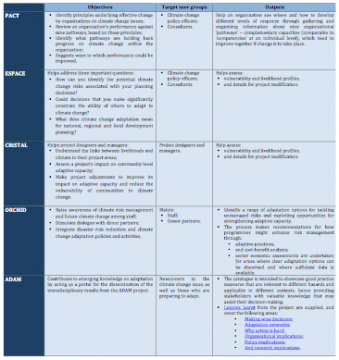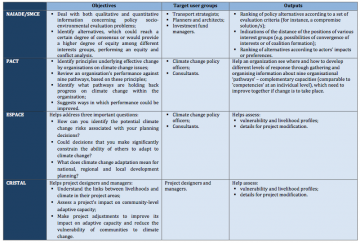Exploring tools from a GOALS – oriented lens

Some tools are used to achieve a particular goal. In this section, the tools have been classified according to three goals:
- 1. Awareness raising;
- 2. Developing programmes, projects and policies for implementing strategies;
- 3. And operationalizing adaptive management strategies.
The table below shows how some tools are oriented towards these objectives:

Download table here
Three features of the tools analyzed have been used to describe their potential in reaching these three goals: their objectives, the user groups they target, and their outputs.
Awareness raising
Example: ORCHID: Mainstreaming Adaptation In Development Investments In the Water Sector In China
The UKCIP tools BACLIAT and the Adaptation Wizard, as well as ADAM, all contribute to raising awareness in different ways, as described in the table below:

Download table here
Developing programmes, projects, and policies for implementing strategies
Example: CRiSTAL: Climate Change Vulnerability Assessment In Zambia
Some tools help assess the impacts of programmes, projects and policies in order to implement strategies that:
- Assess the impacts of climate change;
- Develop and evaluate some adaptive strategies;
- And assess programmes, projects and policies, in order to reduce their negative impacts and promote better efficiency and sustainability.
These tools are mainly PACT, ESPACE, CRiSTAL, ORCHID, and ADAM, as listed in the table below:

Download table here
Operationalizing adaptive management strategies
Example: SMCE/NAIADE: Evaluating The Effects Of The Alumysa Project In The Aysén Region In Chile
The third goal that is examined in this window is the operationalization of adaptive management strategies. The tools that help reach this goal are SMCE/NAIADE, PACT, ESPACE, and CRiSTAL, as listed in the table below:

Download table here
View our
Case studies: Goals-oriented lens
Review of Adaptation Decision Tools
Introduction: Reviewing of adaptation decision tools
Reviewing tools that use a bottom-up approach & recommendations
PACT (Note: this tool has been superseeded by CaDD)
Conditions of Applicability
Case Studies
(0) Comments
There is no content